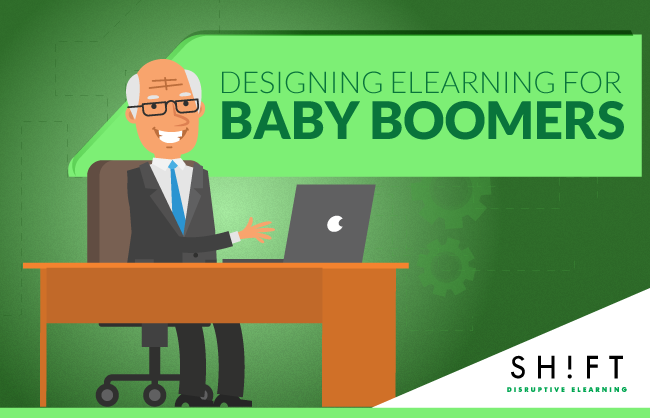Think your organization is too young, hip, and fresh to have baby boomers on its books? Think again.
According to the U.S. Census Bureau, approximately 59,000 Americans over the age of 60 are currently enrolled in colleges and universities. A recent report by the Pew Internet & American Life Project estimates that 70 percent of people aged 50 to 64 uses the Internet, and 33 percent of people over 65 do the same.
Oh and also, did we mention that those over 50 are the fastest growing demographic online? According to Immersion Active, that’s a fact. Wow.
If your eLearning audience are baby boomers then, how do you design eLearning courses that cater to their needs? Well, let’s have a look. What follows is our guide to eLearning design for the baby-boomer audience.

1) Keep it ‘SCP’ – Simple, Personal, Comprehensible
As a generation of people brought up before the beginning of the information age, they need to have technology that is comprehensible and personal. They did not grow up with computers and iPads, so the technology they use needs to be user-friendly. This means that your eLearning should be very user-friendly. It’s better to keep them simple, intuitive, and easy to use. From a design perspective, create a straightforward how-to guide, a written troubleshooting guide, and avoid fonts that are too small or distracting.
These guys were raised to be loyal, so they won’t, by nature; jump off one train just to see if another is faster. They didn’t grow up with ever-changing options regarding tech, so once they find something they like, they’ll stick to it. That probably explains why my mother’s had the same mobile phone for nine years. If you can create trustworthy platforms that users can get familiar with, they’ll stay loyal and engaged in your training programs.
A good guide for you to reflect on, if you’re new to all this, is to do the following:
- Take time to research what platforms they trust and why.
- Reflect on recurring technical issues with your courses or tools.
- Do some fact-finding about any complaints, issues, or quirks that have come up with any other courses at your organization.
If you find a few different mistakes and feel like switching it up a bit, then you can also look into pioneering a new eLearning tool. Remember good eLearning is about choosing the right authoring tool for your audience as well, not just the content. The SHIFT eLearning blog is a great place to learn about new tools and changes happening with the old ones.
2) Know What Baby Boomers Want to Do With Their Newfound Free Time
It’s 2016; most baby boomers are either done working or on the brink of retirement. Craft your eLearning programs around this fact to appeal to them. 72 percent of the participants in one AARP study voiced that they want to spend more time pursuing their favorite hobbies and interests.
Make sure that your courses center on personal growth; people are never too old to want to grow and develop themselves. Equally, though, making your audience feel old is never a good way to go, so emphasize the leisure and ‘fun’ growth element, not the academic merit or expertise that they’ll already have gained over a long career. The substance should be as intellectual as any other, but your delivery methods should make learning enjoyable. Baby boomers aren’t taking your courses because they have to. Much of the time, they aren’t even signing up to improve their careers. They are there because they want to be. Acknowledge this and work with it.
3) Make Open Communication Easy
If you want to appeal to your baby boomer students, make it easy for them to communicate with you. Be sure to include your contact information - a phone number, email address, social media links - on your website and on all of your marketing materials, where it's easy to find. And always respond promptly to people when they reach out to you with a question. The last thing you want is for a student to try to get in touch and sit for a week with no response from you.
In addition to your personal contact information, try to include a FAQ page with the questions that your students ask often. For new courses, foresight is key here. Put yourself into the mind of students to anticipate what could be easily looked over or misunderstood. The more questions you leave unanswered, the more hours you are going to spend responding to inquiries and the less you will have for grading students work and your own leisure.
4) Setup Your eLearning Courses for Team Collaboration
Baby boomers are team-players, so eLearning courses need to have online group collaboration activities. Even for something simple, like a brainstorming activity, a group collaboration could be beneficial. Forums are also exceptionally useful for this purpose, so consider including a forum where learners who can’t get by on the FAQ page alone can post – particularly if you want to add in an extra step before they contact you.
Since this demographic won’t likely know, intuitively, how to use all of the group features in your platform, introduce them to these tools through mini projects that help them learn to navigate them. You can get creative here and give students the chance to get acquainted with one another at the same time as they’re learning to navigate the system.
5) Provide Personalized Feedback for the Coursework
Baby Boomers don't seem to respond well to criticism, even in a constructive sense. It seems to disappoint rather than motivate. You can and should, however, provide personalized, one-on-one feedback. Students will value the attention they get from you or the other students or staff.
To give feedback properly, set up some guidelines. If the subjects you’re approaching are personal, make sure that you send private messages. If your thoughts could be helpful for the other students, posting your notes in public will be fine. In some cases, you can ask other students to provide useful and polite feedback on fellow participants for a part of their own grade.
6) Goals and Milestones!
This generation is less about embracing the moment, and more about attaining measurable objectives. They are goal-centric. eLearning programs then should contain at the very least a progression bar or a checklist. If you’re integrating with an LMS for a particular project, then, of course, having a progress display is beneficial. Make sure that your courses are organized with milestones that are visible for students with deadlines and clear purpose. The baby boomers will enjoy taking advantage of them, and will have an easier time absorbing the information they’re presented with.
Baby boomers aren’t all home crafting and playing golf. Many of them are still working hard, and they will take up a big chunk of your enrollment lists. As an eLearning professional, it is important for you to have courses that are setup to appeal to them.
The first thing you need to do is make sure your technology is suited to them by using user-friendly and trusted software in your courses. Next, understand the perspective of the average baby boomer, realizing that these guys aren’t here to get a promotion in the workplace. Then, make sure that your students’ questions can be answered easily, and that you are available to chat, as a real person, not just a robot or an autoresponder. Ensure that your courses are setup in a way that makes collaborating on projects and brainstorming easy. Rather than criticizing work, provide personalized feedback for baby boomers. And, finally, nurture their goal centric nature with progression bars or checklists within the eLearning platform.
If you need to make any changes to your courses to make them work better for your students aged 52 to 70, get out there and start implementing these tips today.
Author Bio:
Megan Hicks is an eLearning enthusiast, currently working as a counselor at writethisessay.net writing company. She is now working out new ways to make eLearning more appealing to a wider audience.







